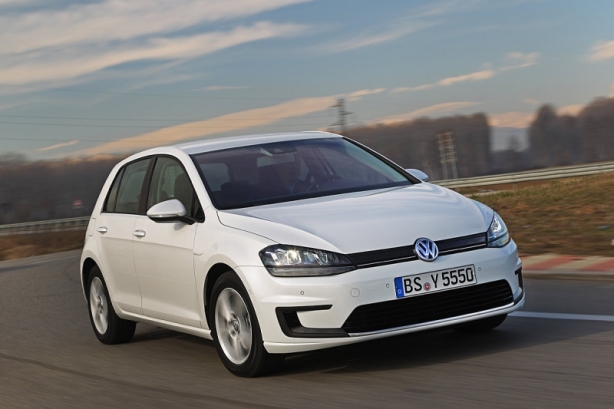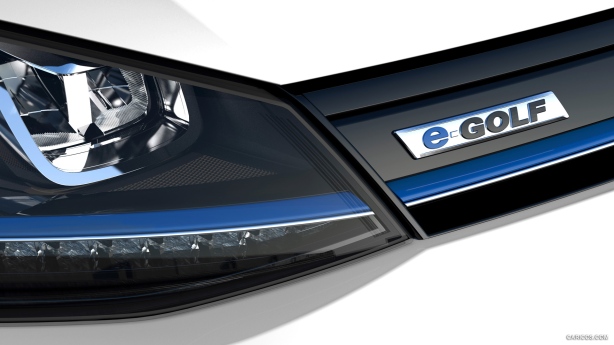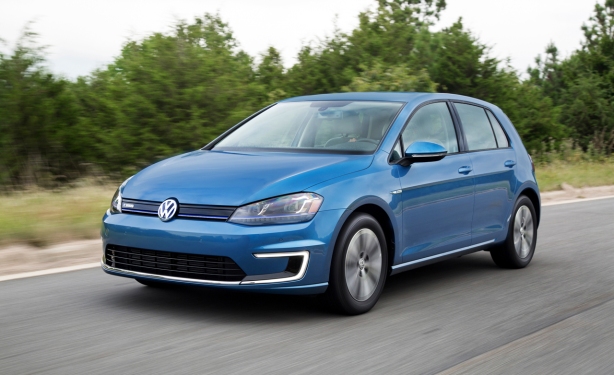The 2015 Volkswagen e-Golf is an accomplished new contender for the best, relatively-affordable electric vehicle without a Tesla badge.
If I didn’t know this was a compliance and engineering exercise for VW, I might think that the e-Golf could be a true mass-market EV like the Nissan Leaf.
The e-Golf looks like pretty much any other 2015 Golf, and that’s a good thing. This 7th generation Golf wears an evolutionary, more mature, handsome sheet metal with sharper creases and more angular front and rear lights.
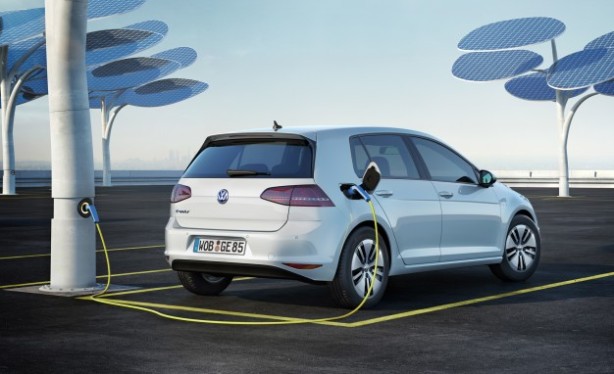
Every inch of sheet metal seems tightly stretched over the frame. Note the angular taillights that replace the more rounded ones from the Golf Mk6.
This new generation Golf is built on VW’s corporate multi-billion euro MQB platform that will underpin dozens of new front- and all-wheel drive vehicles spanning several brands (VW, Audi, Škoda, SEAT). From the beginning, MQB was engineered to accept all types of drivetrains, including hybrid, battery-electric and fuel cell.
The e-Golf is VW’s first EV in the US market and for a freshman, it must have done some advanced placement studies to put it at the top of small, but growing list of battery-electric vehicles (BEVs). I’m told that it is targeted just below the Mercedes-Benz B-Class Electric and the BMW i3 but above offerings like the Nissan Leaf, Ford Focus Electric and Kia Soul EV.
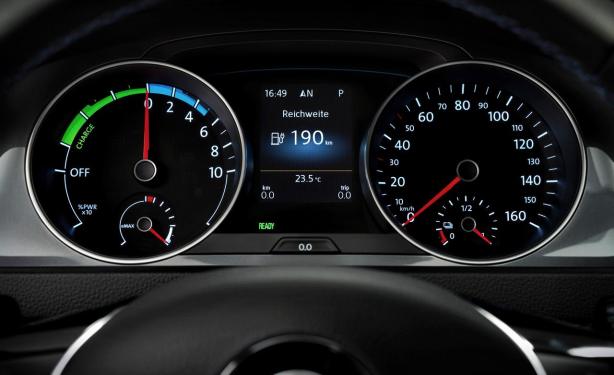
The instrument panel of the e-Golf looks nearly the same as the standard Golf except the analog gauges show the battery charge rather than fuel level.
It’s kind of a lofty goal to take on BMW and Mercedes in the BEV arena, but the e-Golf is convincing, in a very conventional way. In every way, it’s a familiar Golf. It looks like a Golf, has the same interior as any other Golf and the same cargo space.
So what’s it like to drive? Get in, press start and the dash lights up. Silence, of course.
The 85 kW AC motor is good for 115 hp and 199 lb-ft of torque. As you’d expect, acceleration from a standstill is brisk with all the torque instantly available. As with other Golfs, the dreaded torque steer from a front drive car has been abolished. Power delivery is smooth and linear, but you won’t beat most cars in a drag race. Zero to 60 is a leisurely, but acceptable 10.4 seconds. Top speed is limited to a rather conservative 87 mph.
The electric power steering is excellent, if numb. I’ve come to expect it these days with everyone going to electric (rather than hydraulic) power steering. It tracked dead on-center and the electric power assist was a Goldilocks “just right” – not too heavy, not too light.
Quietness is also a virtue of the e-Golf. You don’t hear any electric motor moaning and VW packed extra soundproofing materials for a very hushed cabin. The suspension easily soaked up most road roughness and the extra battery weight keeps the car planted. Road noise – which is always more noticeable in a quiet EV – was present, but distant.
Volkswagen opted for a 24.2 kWh liquid cooled lithium-ion batter pack, mostly under the seats, and rear hatch area in place of a spare tire and gas tank. While not a huge battery, it is surprisingly efficient, as the e-Golf earned a very respectable 116 MPGe. Range, however, is only rated at 83 miles, which is only slightly better than average for anything that’s not a Tesla.
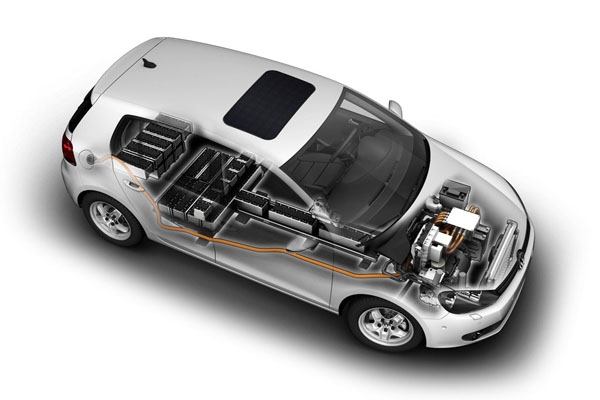
This transparent view of the e-Golf shows the placement of the battery along the floor, under the rear seats and in the cargo area. The weight is spread out very well making the e-Golf well-balanced with a low center of gravity.
As with other EVs, the weight of the battery on the floor, mostly in the center/rear of the car lowers the center of gravity and more evenly balances the weight between all four wheels. With a beefed up suspension and excellent tuning, the e-Golf handles better than any Golf not wearing an R badge.
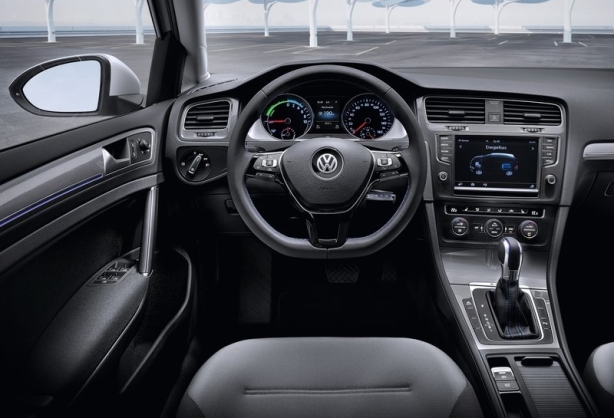
Cockpit of the 2015 e-Golf. Note the electronic parking brake in the center area and the covered cup holders.
The e-Golf operates in one of three driving modes selected from the center touch screen: Normal, Eco and Eco+.
In Normal mode, the car drives in a very conventional manner – If it wasn’t silent, you might think you were driving a conventional Golf. The climate control functions normally and the electric motor operates at full power for maximum driving fun.
Select Eco and the HVAC system gets dialed back (fine when it’s 72 outside, but not so much when it’s 95) and power is dialed back to 94 hp and torque to 162 lb-ft and the top speed drops to 72 mph. Eco mode is fine for normal daily slogs in traffic, but not spirited sprints or LA freeway driving when you can go from a standstill to 80 mph at any given time.
Select Eco+ and you lose AC all together and the motor is hobbled to 74 hp and 129 lb-ft of torque with a top speed of 56 mph. Driving the car in Eco+ mode all the time will likely stretch the range past 100 miles, but I know myself, and I’d not be happy slogging along without AC and with only barely passable power for a car weighing 3,391 pounds.
However all is not lost if you’re driving in one of the Eco modes. If you mash the accelerator to floor, the car reads your mind and reverts to Normal mode for maximum power usage. This is a smart, fail-safe plan.
Regenerative braking is also an area in which the e-Golf excels. One of the geeky things EV owners love is playing around with regenerative brakes to slow or almost stop the car. You can drive the e-Golf in the B mode (just below D) which provides the heaviest amount of regen-braking. Yes, geek out in B and, with some practice, perform one-pedal driving – the car will coast itself to a full stop, with pronounced braking as soon as you lift off the go-pedal.
The other two modes are D2 and D3, accessed by tapping the shifter to the left when in Drive. Each mode provides additional regenerative braking. A clever safety trick that other EVs don’t offer is that when driving in any mode other than D1/Drive, as soon as you let up on the accelerator, your brake lights go on, warning drivers behind you that you are braking even though your’re not pushing the brake pedal.
I drove the car in all modes and liked each one for different reasons. I did wish that VW had put paddle shifters on the steering wheel to activate regenerative braking, but that’s a small ding. I’d probably end up driving it B mode all the time and pat myself on the back for barely touching the mechanical brakes – after all, I am a car geek.
The Good:
- All the goodness of the excellent Golf Mk7
- Refined electric powertrain
- Three levels of regenerative braking – from mild “normal” to near 1-pedal operation
- Obligatory smartphone app to monitor
- First rate interior for a non-luxury car
- Precise, well-weighted steering
- Made in Germany, not Mexico
- Impressive fit of body panels
- Slick aerodynamic aluminum alloy wheels – not cheap plastic covers over steel wheels
- Two SD memory card slots in chilled glove box – but who uses SD memory cards for their music?
- Automatic headlights and rain sensing wipers
- Keyless entry and start
- Aced its crash tests with top ratings
The Not So Good:
- Smallish 5.8″ touchscreen
- No USB ports – Really?
- Short-leash, complicated media cable to tether your smartphone
- No sunroof – but it does save weight
- No HomeLink
- Annoying delay in rear view camera operation due to placement of cam under large rear VW badge
- Antique,unnecessarily large switchblade key fob that the VW group has been using for more than a decade. Time for a change.
- Some cheap hard plastics on lower fascia panels
- No leather seat option – only perforated “leatherette”
- DC fast charging system uses CCS (Combined Charging System) and there aren’t many locations for this yet
- No Driver Assistant package available as with other Golfs (forward collision warning and front/rear parking sensors)
The e-Golf comes in only one trim level – SEL Premium – for $36,245. No option packages are available (yet). VW doesn’t have any lease deals, so with around $2,000 down, I was quoted a 36 month lease price of around $420/month (including tax). That’s significantly more than the Soul EV and on par with a similarly-equipped Nissan Leaf. As more inventory becomes available, I think VW Credit will come up with a good lease incentive, but only time will tell.
To summarize, the 2015 e-Golf is a very satisfying, capable electric car. It’s refinement and every-day utility puts it at the top of my list, along side the 2015 Kia Soul EV.
